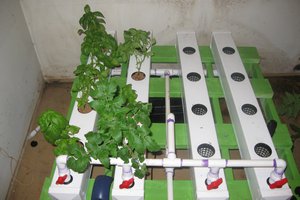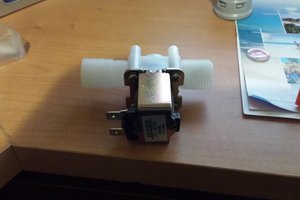Building the mechanical part of the fountain involved some experimentation. Initially, I thought that I would use ceramic bowls for the cascade pans, but all of the bowls that I could find had a hole in the bottom to drain water. I got some shallow bowls that did not have the hole in the bottom and assumed that I would put the bowl at a slight angle to get the water to spill out in a sort of controlled area. As soon as I tried this, it was apparent that this was a bad idea. With a reasonable tilt on the bowl. the water ran randomly down the side of the bowl, rather than separating cleanly to drop to the next bowl. I looked around locally for bowls with a pour spout on them and could not find anything suitable, so the round bowls became fabricated pans with spouts. When I tested the new pans (as seen in the photos) I realized that I should have installed the spouts lower on the side of the pans. The water level in the pan rises very close to the top edge of the pans as they are made now. Incidentally, the big catch pot shown had a drain hole in the bottom, and I filled it with fiberglass and epoxy.
When I started the project, I was not sure what kind of pump I was going to use. A low voltage DC pump would be much easier to power and control than a 120VAC pump, but most of the inexpensive small pumps I have messed with, would have a hard time lifting water the 3.3' to the top pan. The Surplus Center (a favorite place for mechanical bits) has some 12V brushless DC pumps that looked like they might work, so I ordered a couple.
Testing this morning showed that the pump works great for this application. The pump pulls about 850mA at 12.2V which is a little bit inconvenient, as most solar panels in that size range put out about 12V. My plan is to put 2 12V 10W panels in series to get 24V @ 20W, and use a buck regulator to drop the pump voltage down to the 9.0 - 12.0V range for some adjustability on the pump output. I would like to have the fountain run a little bit after dark, so I am going to put a gel cell battery in to provide power after the sun goes down. Gel Cells work fine with float charging to a fixed voltage, so the charging controller will not be complex. The design on the timer is still evolving. Implementing the whole controller as an analog project has a lot of appeal to me right now.
 Bharbour
Bharbour


 matthewkleinmann
matthewkleinmann
 AVR
AVR
 Julius (Mr. Seeker)
Julius (Mr. Seeker)
It can be difficult to get pumps to start during periods of marginal sunlight due to starting current being greater than running current. There are circuits on the 'net for "solar engines" that are supposed to overcome this problem but most of them are for lower voltages. I have experimented with 6 Volt pumps with and without "solar engines" and find little difference if the solar panel is generously rated.
Many solar panels are rated for wattage by muitiplying the open-circuit voltage by the short-circuit current but this is not how panels operate in real situations. Also some panels have reducing current as their temperature rises. Any panel needs to be tested under working conditions to establish its true performance. I normally derate panels to 70% of their advertised wattage before splashing my hard-earned.
I would recommend that you put your two panels in parallel and connect them directly to the pump. The two in parallel will give you double the available current to get more reliable starting and operation during times of marginal light
To control water flow, it might be better to use an adjustable valve in the output pipe and control the water directly rather than by varying the voltage.
Adding a battery to get some night operation adds complexity. A gel cell will need some sort of low-voltage cut-off to ensure that it is not fully discharged because gel cells don't like being discharged too deeply. Nicad's, NI-Mh's can be fully discharged but will demand high charge currents when the sun reappears and this reduces the current available for the pump. Li-ion batteries have charge-discharge rules if they are not to self-destruct. Of course charge controllers can be designed to charge the battery of choice but is the after-dark capability worth the extra complexity? And is there enough surplus current from your panels to fully charge the battery? Only real-life testing will show.
A mains plug-in timer with a 12 Volt wall wart and blocking diode could provide your after-dark capability. I know it's not "pure" but it works and does not have all the hassles of batteries and charge controllers - not to mention cheap.
One of the purposes for my solar pump is to provide the sound of fallng water. I cheated with the sound after dark. At night a PIR sensor detects any human presence and plays a recording of the falling water (LDR, PIR sensor, Arduino Nano, DFPlayer Mini+SD card).